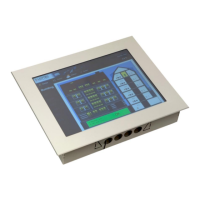L-VIS User Manual 269 LOYTEC
Version 6.2 LOYTEC electronics GmbH
static interface of the already integrated device and take over the existing bindings. The
recommended procedure is as follows:
Run the configuration software in standalone mode and connect to the device,
preferably using a TCP/IP connection.
Load the current project from a file or from the device and modify it as required,
adding or removing static NV data points.
Download the new project to the device. A warning appears, stating that this
operation will change the static interface and that the configuration software will
not be able to automatically upgrade your device in the network.
In case you are connected over CEA-709, another warning will tell you that the
connection will be lost after the download, because the device will go to un-
configured state due to the static interface change. It is therefore recommended to
use TCP/IP for the connection.
After the device restarted, use the Export XIF… function from the Tools menu
to generate a new XIF file, matching the new configuration of the device.
Execute the standard procedure of your network management tool to replace the
old device with a new device and use the new XIF file to define the new
interface.
NOTE: The above procedure assumes that there are no dynamic NVs present on the device.
Manually changing the static interface of a device is not supported by any of the common
network management tools, when there are dynamic NVs present at the same time.
Therefore, updates to the static interface in mixed projects can only be done in plug-in
mode.
12.4 Configuration Recovery
This section describes procedures to recover from situations where the current
configuration of the device does not match the current definition of the device in the
network. This may happen as a result of a failed upgrade procedure or because the
definition of the device in the network changed because the network had to be restored
from an older backup.
Basically, there are two ways to resolve any such conflict:
Change the configuration of the device to match the current definition in the
network.
Change the definition of the device in the network to match the current
configuration.
The decision depends on the desired end result, that is, if the current network definition or
the current device configuration is closer to the desired end result.
12.4.1 Change Device Configuration
In case the current definition of the device in the network represents the desired end result,
the configuration of the device should be set back to match the definition in the database.
This of course is only possible if a matching project is still available as a file on a PC.
Assuming that a suitable project file is available, the device may be easily restored by
following the appropriate procedure for a device replacement, as outlined earlier in this
document.

